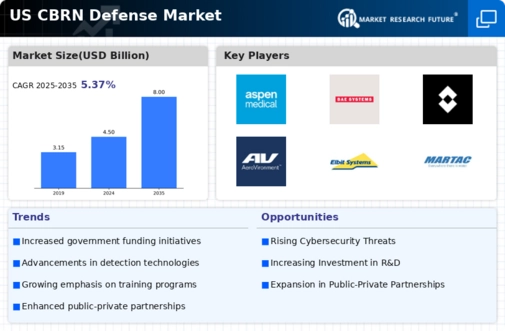The US CBRN Defense Market is an essential segment of the broader defense landscape, focusing on the protection against Chemical, Biological, Radiological, and Nuclear threats. Given the increasing prevalence of asymmetric warfare and the evolving nature of terrorist threats, this market has seen heightened investment and innovation. Competitive insights reveal a landscape characterized by rapid technological advances, strong governmental support, and collaboration between public and private sectors. Companies are striving to develop advanced detection, decontamination, and protective gear, often leveraging cutting-edge technologies such as artificial intelligence and machine learning to enhance the effectiveness and responsiveness of their solutions.
The competition is fierce, with numerous players vying for contracts and partnerships, making it a dynamic and rapidly evolving market.Aspen Medical stands out in the US CBRN Defense Market due to its unique service offerings and an impressive track record in providing high-quality medical solutions in challenging environments. The company has established a solid reputation for delivering tailored healthcare services and operational support, essential for both military and civilian applications. Aspen Medical boasts a team of highly skilled personnel and specialists trained to respond effectively to CBRN incidents, which strengthens its market presence.
This focus on specialized healthcare capabilities creates a competitive edge, enabling the company to meet the diverse needs of its clients in the defense sector. Additionally, Aspen Medical's commitment to quality and comprehensive training programs enhances their reliability, making them a preferred partner in the US CBRN defense space.Raytheon Technologies plays a critical role in the US CBRN Defense Market, with a robust portfolio of products and services addressing various aspects of CBRN threats. The company excels in the design and manufacturing of advanced detection systems, protective equipment, and decontamination solutions that are integral to national security and force protection.
Raytheon Technologies has a strong market presence, bolstered by strategic mergers and acquisitions that have expanded its technological capabilities and market reach. Its focus on innovation through research and development allows the company to stay ahead of the curve, delivering state-of-the-art solutions that meet the evolving threat landscape. With a commitment to strengthening its partnerships with government agencies and military organizations, Raytheon Technologies continually invests in enhancing its capabilities and solutions, ensuring that it remains a key player in the US CBRN Defense Market.




















Leave a Comment